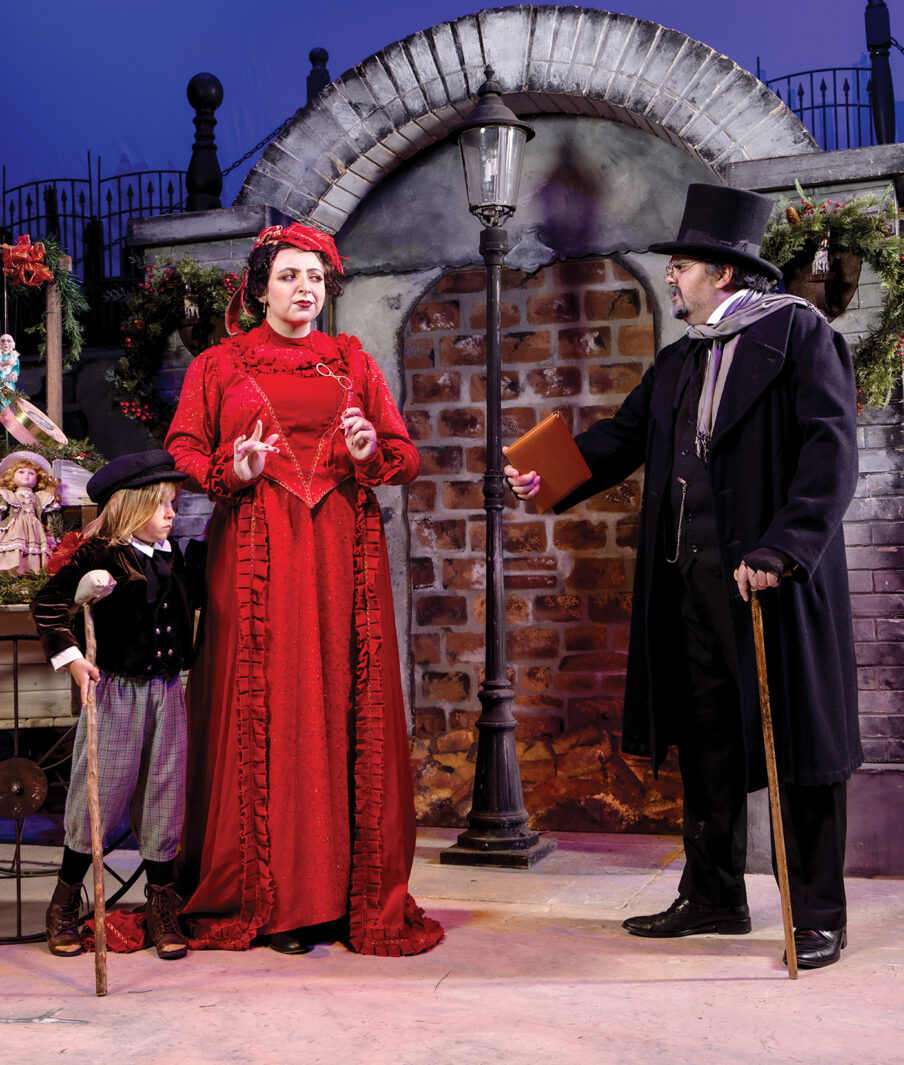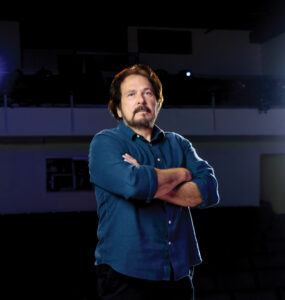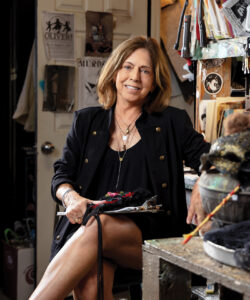
Actors run through scenes from “A Christmas Carol” in a dress rehearsal. // Photos by Chad Riley
A hush falls over the packed theater, quieting the giggling voices of little girls clad in velvet dresses and stockinged feet as they find their seats. The last of the light in the quickly darkening room dances brightly in their eyes in anticipation of the most classic of holiday tales: “A Christmas Carol.” The curtain swings open, the sparkling stage dressed as meticulously as a Christmas tree. And just like that, it’s showtime at Playhouse in the Park.
Pam and Danny Mollise have quite literally been running the show at Mobile’s beloved community theater for 40 years. Danny’s own history at the Playhouse reaches as far back as 1967, when his mother took him to his first audition at 8 years old. He was cast in his first show, and the rest is history.
“I spent my childhood here,” Danny recalls from his front row seat at the theater where I meet he and his wife, Pam, to learn a little more about the local theater nestled in the heart of Spring Hill. “I studied theater in college in New York, and after graduation, I had plans to attend film school at the University of Texas, but the Playhouse board of directors called me with an offer I couldn’t refuse. They were in need of a new director, and the board essentially presented me a budget and asked which show I would like to do. It was 1984, and ‘Annie’ was really popular at the time, so I went for it.”
Unbeknownst to Danny, his choice of “Annie” brought with it much more than the popular screenplay of the time. It also marked the start of a lifelong career as managing director of Playhouse in the Park, as well as the day he met his future employee, business partner and, most importantly, wife.
When auditions for “Annie” were announced, Pam decided to bring her 5-year-old daughter in to audition. Over 400 people showed up, but Pam’s daughter made the cast list. A talented artist herself, Pam immediately went to work volunteering on set design, props, costumes, and hair and makeup. She was such a big help that she soon found herself working full time as the scenic and costume designer for the theater, and not long after, married to Danny.
“Danny is the visionary, while I am more of the details,” Pam explains. “He is also an actor himself, as well as a musician, and I do the hair, costumes, makeup, set design and props. Essentially, we are a small business; we do everything ourselves. During the shows, you will find Danny in the control booth and me backstage. Together we are the perfect storm. The secret to our success for 40 years has been in that consistency of collaboration.”
And if the collaboration fails? “I do whatever she says,” Danny laughs.
Left Playhouse Managing Director Danny Mollise. Right Playhouse Scenic and Costume Designer and Stage Manager Pam Mollise.
This year alone, the Playhouse will present 60 performances. It depends on the demand of the daytime shows usually reserved for school audiences, which was as high as ever this holiday season: All 12 daytime shows of “A Christmas Carol” sold out in five days. This feat is especially exciting for the Mollises who have a special name for the writer of this year’s original adaption of the Christmas classic: daughter. “Usually, we put on our Christmas production at the Saenger Theater downtown, where we are able to accommodate 7,000 theatergoers over the course of the show’s run,” Danny explains. “But this year we decided to bring it home to the Playhouse where our thousands of costumes, props and 14 complete set designs live, making it more convenient for production purposes, but narrowing the audience down to 4,000 ticket holders total.”
The theater sits nestled within a haven of other local amenities serving the community, ranging from gardens, art museums and nature trails to tennis courts, baseball fields, playgrounds and parks. Originally it was located around the corner where Rouses Supermarket sits in the Spring Hill Village Shopping Center. The city offered the current property to the theater but placed the responsibility of construction costs on the small non-profit. When it was announced that the theater children would be selling individual bricks from the original building for $1 a brick to fund construction, Lem Morrison, local philanthropist and owner of Dairy Fresh, offered to match the value of each brick sold. No one was more surprised than Mr. Morrison himself when the children successfully sold every single brick: 47,000 in total. He upheld his end of the deal, and the new theater was built for a total cost of $48,000. “I remember Mr. Morrison telling me that Dairy Fresh had to halt advertising for a year in order to keep his word to the children of the theater,” Danny laughs. “In the mid-1980s, the theater benefitted again from the generosity of Mr. Morrison when his contribution literally made Peter Pan fly by funding the flying equipment rental costs and training fees for the show, all of which are still used as stunning effects during productions of ‘Peter Pan’ and ‘Mary Poppins’ today.”
Originally built as a puppet theater, the building lacked modern theater resources to thrive in a new age, and in 1999, the theater underwent a transformational $1 million renovation, adding a lobby, digital sound and lighting, classroom studios and balcony seating, making the Playhouse in the Park one of the largest community theaters in the Southeast. Now Danny can proudly say that the space is designed strictly to be a theater. “It was not built to be a multipurpose space, like the stages found in most high school auditoriums, so we are really lucky. The intention was for this space to always serve as a theater, and we intend to ensure it stays that way.” The Mollises take the same no-nonsense approach to not only the facility but to the craft that goes on inside. “We base our concept and style on the Alabama Shakespeare Festival, that level of professionalism and showmanship, with a variety of show material and state-of-the-art lighting, sound and sets,” Danny explains. “We have classes here, with a great pool of tradesmen to draw from: voice teachers, choreographers, dancers, set and prop design artists like Pam. We truly approach this from a professional mindset. Because to us it is professional — it’s our job.”
While the Mollises are clearly the cornerstone of the theater, they are quick to point toward others in the community who help make the Playhouse in the Park possible. The nonprofit employs four people year-round, and the small crew, along with each show’s cast, fosters a true family atmosphere. Although the typical ages of the cast at the Playhouse range from 6-25, many of the young adults stay on long past their last curtain call. “Even after our kids turn 25, they still come back and become legacy showmen,” Danny says. “We have original theater kids whose children are in our shows now. We have had some really successful kids come out of our theater, kids that have ended up on Broadway with lead roles, some who have become performers at Disney, some who have become repertoire actors or drama teachers themselves. And despite their success, they still come back here and do shows with us. So, we know we must be doing something right.”
And while sold-out shows and successful acting careers are wonderful fruits of their labor, the Mollises seek something much bigger than awards and accolades. “The important thing is not necessarily the acting itself; it’s the life skills learned,” says Danny. “Our kids learn how to work together, they develop great work ethic and they gain tremendous confidence. Kids today tend to get a bad reputation for being lazy or self-centered, but we don’t see that. There are so many smart and talented kids in this city who can sing and dance and act and create art for the set. These kids come in here, and they take ownership of the theater in the same way we do.”
During a production, backstage is madness. Pam laughs, saying “Mary Poppins has under a minute to fully change her entire look from top to bottom — boots, dress, hat, gloves — during each of her five costume changes.” Danny pulls out his phone for video evidence. Sure enough, Mary Poppins walks offstage and is immediately surrounded by five people who work like racetrack technicians changing tires. Her entire look transforms in 57 seconds flat, and she even turns and gives the camera a thumbs up before she is handed an umbrella and walks effortlessly back onstage.
Between shows, those costumes hang in the upstairs costume and prop “closet,” and my mouth drops open when I see it in person. “It’s vast,” Pam understates. By vast she means means 3,000 costumes hanging in two rows from floor to ceiling in a space about the size of a small classroom. Out of habit, Pam immediately gets to work, pulling skirts that need hemming or blouses that need ironing.
Coming back down those same stairs, the walls are graffitied with kids’ names where each cast member has signed at the close of their show. It reminds me of the names and years scrawled on the wall in my parent’s pantry, measuring the heights of family members, friends, neighbors and now grandchildren, a beloved measuring stick of time and history. I can see in Pam’s eyes that it means the same to her.
“When I was a teenager here, this was my home. This was where I fit in,” Danny recalls. “And I see that same sense of belonging in the kids here today.”
With Danny in the director’s chair and Pam backstage, the children of our community can rest assured that their beloved theater will continue to open its curtains for years to come.







